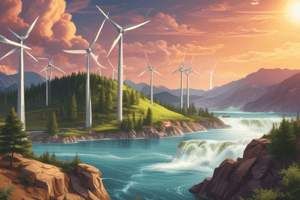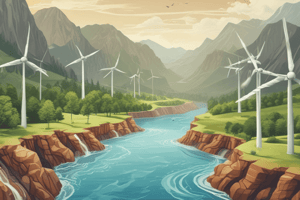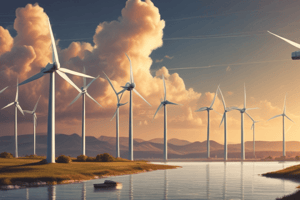Podcast
Questions and Answers
The United States only relies on nonrenewable sources of energy.
The United States only relies on nonrenewable sources of energy.
False (B)
Renewable energy comes from resources that can be used repeatedly without depletion.
Renewable energy comes from resources that can be used repeatedly without depletion.
True (A)
Renewable energy can only be used to generate electricity.
Renewable energy can only be used to generate electricity.
False (B)
Turbines convert wind energy into electricity.
Turbines convert wind energy into electricity.
Wind energy is not a renewable resource.
Wind energy is not a renewable resource.
Hydroelectric power is mostly produced by windmills.
Hydroelectric power is mostly produced by windmills.
Solar energy collection is limited by weather conditions.
Solar energy collection is limited by weather conditions.
Biofuel generates a lot of energy.
Biofuel generates a lot of energy.
- Renewable energy comes from widely available and quickly regenerating resources that can be used repeatedly without ______.
- Renewable energy comes from widely available and quickly regenerating resources that can be used repeatedly without ______.
- Wind energy is a renewable resource, but turbines can harm ______.
- Wind energy is a renewable resource, but turbines can harm ______.
- Hydroelectric power is mostly produced by ______, which harness the power of water to generate electricity.
- Hydroelectric power is mostly produced by ______, which harness the power of water to generate electricity.
- Dams impact ______ in rivers and can cause a loss of habitat for many types of wildlife.
- Dams impact ______ in rivers and can cause a loss of habitat for many types of wildlife.
- Biofuel is a fuel made from ______, which is material from living or recently living things.
- Biofuel is a fuel made from ______, which is material from living or recently living things.
- Geothermal energy is heat produced deep inside the Earth that can be captured through power plants or heat pumps, but is ______ and can trigger earthquakes.
- Geothermal energy is heat produced deep inside the Earth that can be captured through power plants or heat pumps, but is ______ and can trigger earthquakes.
- Solar energy is created when sunlight is converted into electricity through solar panels, but installation is ______ and solar energy collection is limited by weather conditions.
- Solar energy is created when sunlight is converted into electricity through solar panels, but installation is ______ and solar energy collection is limited by weather conditions.
- Geothermal energy is renewable and environmentally friendly, but only available in ______ locations.
- Geothermal energy is renewable and environmentally friendly, but only available in ______ locations.
What is renewable energy?
What is renewable energy?
How is wind energy collected?
How is wind energy collected?
What percentage of the world's needed electricity does wind energy supply?
What percentage of the world's needed electricity does wind energy supply?
How is hydroelectric power mostly produced?
How is hydroelectric power mostly produced?
What is the impact of dams on fisheries and wildlife in rivers?
What is the impact of dams on fisheries and wildlife in rivers?
What is biofuel?
What is biofuel?
What is geothermal energy?
What is geothermal energy?
Is geothermal energy renewable?
Is geothermal energy renewable?
What is renewable energy?
What is renewable energy?
What is the main disadvantage of wind energy?
What is the main disadvantage of wind energy?
What is the main disadvantage of hydroelectric power?
What is the main disadvantage of hydroelectric power?
What is biofuel?
What is biofuel?
What is geothermal energy?
What is geothermal energy?
What is the importance of renewable energy?
What is the importance of renewable energy?
What percentage of the world's electricity needs does wind energy supply?
What percentage of the world's electricity needs does wind energy supply?
How much solar energy received by the Earth in one day is enough to supply current energy needs for 30 years according to scientists?
How much solar energy received by the Earth in one day is enough to supply current energy needs for 30 years according to scientists?
Flashcards
Renewable Energy
Renewable Energy
Energy from resources that replenish quickly.
Nonrenewable Energy examples
Nonrenewable Energy examples
Coal, oil, and natural gas.
Wind Energy
Wind Energy
Converting wind motion into electricity.
Hydroelectric Power
Hydroelectric Power
Signup and view all the flashcards
Solar Energy
Solar Energy
Signup and view all the flashcards
Biofuel
Biofuel
Signup and view all the flashcards
Geothermal Energy
Geothermal Energy
Signup and view all the flashcards
Wind Turbines
Wind Turbines
Signup and view all the flashcards
Dams
Dams
Signup and view all the flashcards
Biomass
Biomass
Signup and view all the flashcards
Geothermal Power Plants
Geothermal Power Plants
Signup and view all the flashcards
Geothermal Heat Pumps
Geothermal Heat Pumps
Signup and view all the flashcards
Wind Turbines downside
Wind Turbines downside
Signup and view all the flashcards
Dams Downside
Dams Downside
Signup and view all the flashcards
Solar Power downside
Solar Power downside
Signup and view all the flashcards
Biofuel downside
Biofuel downside
Signup and view all the flashcards
Geothermal energy downside
Geothermal energy downside
Signup and view all the flashcards
Renewable Resources
Renewable Resources
Signup and view all the flashcards
Wind power
Wind power
Signup and view all the flashcards
Hydroelectric power
Hydroelectric power
Signup and view all the flashcards
Solar energy conversion
Solar energy conversion
Signup and view all the flashcards
Biofuel properties
Biofuel properties
Signup and view all the flashcards
Geothermal process
Geothermal process
Signup and view all the flashcards
How do Wind Turbines work?
How do Wind Turbines work?
Signup and view all the flashcards
What do dams accomplish?
What do dams accomplish?
Signup and view all the flashcards
What creates biomass?
What creates biomass?
Signup and view all the flashcards
Why use Geothermal
Why use Geothermal
Signup and view all the flashcards
The effect that wind turbines have on birds
The effect that wind turbines have on birds
Signup and view all the flashcards
Ecosystem effect of Dams
Ecosystem effect of Dams
Signup and view all the flashcards
Earth's Solar Energy
Earth's Solar Energy
Signup and view all the flashcards
Study Notes
Overview of Renewable Energy Sources
- The United States relies on nonrenewable sources of energy like coal, oil, and natural gas, but also uses renewable resources for energy.
- Renewable energy comes from widely available and quickly regenerating resources that can be used repeatedly without depletion.
- Renewable energy can be used to generate electricity, power air and water heating and cooling, vehicles, and systems outside of cities.
- Wind energy can be collected through windmills and turbines, with turbines converting wind energy into electricity.
- Wind energy is a renewable resource, but turbines can harm wildlife and only supply about 5% of the world's needed electricity.
- Hydroelectric power is mostly produced by dams, which harness the power of water to generate electricity.
- Dams impact fisheries and wildlife in rivers and can cause a loss of habitat for many types of wildlife.
- Hydropower can also be generated from ocean waves and tides but can disrupt ocean life and habitats.
- Solar energy is created when sunlight is converted into electricity through solar panels, but installation is expensive and solar energy collection is limited by weather conditions.
- Biofuel is a fuel made from biomass, which is material from living or recently living things, and is a clean fuel source for transportation but does not generate a lot of energy.
- Geothermal energy is heat produced deep inside the Earth that can be captured through power plants or heat pumps, but is expensive and can trigger earthquakes.
- Geothermal energy is renewable and environmentally friendly, but only available in specific locations.
Overview of Renewable Energy Sources
- The United States relies on nonrenewable sources of energy like coal, oil, and natural gas, but also uses renewable resources for energy.
- Renewable energy comes from widely available and quickly regenerating resources that can be used repeatedly without depletion.
- Renewable energy can be used to generate electricity, power air and water heating and cooling, vehicles, and systems outside of cities.
- Wind energy can be collected through windmills and turbines, with turbines converting wind energy into electricity.
- Wind energy is a renewable resource, but turbines can harm wildlife and only supply about 5% of the world's needed electricity.
- Hydroelectric power is mostly produced by dams, which harness the power of water to generate electricity.
- Dams impact fisheries and wildlife in rivers and can cause a loss of habitat for many types of wildlife.
- Hydropower can also be generated from ocean waves and tides but can disrupt ocean life and habitats.
- Solar energy is created when sunlight is converted into electricity through solar panels, but installation is expensive and solar energy collection is limited by weather conditions.
- Biofuel is a fuel made from biomass, which is material from living or recently living things, and is a clean fuel source for transportation but does not generate a lot of energy.
- Geothermal energy is heat produced deep inside the Earth that can be captured through power plants or heat pumps, but is expensive and can trigger earthquakes.
- Geothermal energy is renewable and environmentally friendly, but only available in specific locations.
Overview of Renewable Energy Sources
- The United States relies on nonrenewable sources of energy like coal, oil, and natural gas, but also uses renewable resources for energy.
- Renewable energy comes from widely available and quickly regenerating resources that can be used repeatedly without depletion.
- Renewable energy can be used to generate electricity, power air and water heating and cooling, vehicles, and systems outside of cities.
- Wind energy can be collected through windmills and turbines, with turbines converting wind energy into electricity.
- Wind energy is a renewable resource, but turbines can harm wildlife and only supply about 5% of the world's needed electricity.
- Hydroelectric power is mostly produced by dams, which harness the power of water to generate electricity.
- Dams impact fisheries and wildlife in rivers and can cause a loss of habitat for many types of wildlife.
- Hydropower can also be generated from ocean waves and tides but can disrupt ocean life and habitats.
- Solar energy is created when sunlight is converted into electricity through solar panels, but installation is expensive and solar energy collection is limited by weather conditions.
- Biofuel is a fuel made from biomass, which is material from living or recently living things, and is a clean fuel source for transportation but does not generate a lot of energy.
- Geothermal energy is heat produced deep inside the Earth that can be captured through power plants or heat pumps, but is expensive and can trigger earthquakes.
- Geothermal energy is renewable and environmentally friendly, but only available in specific locations.
Overview of Renewable Energy Sources
- Renewable energy comes from renewable resources that are widely available and can be regenerated quickly, if at all.
- Renewable energy can be used repeatedly without depletion and is used to generate electricity for various purposes.
- Wind energy can be collected through wind turbines, which convert wind energy into electricity, but turbines pose a threat to wildlife.
- Hydroelectric power is mostly produced by dams, which harness the power of water to generate electricity, but can negatively impact fisheries and wildlife in rivers.
- Hydropower can also be produced from ocean dams, but it can also disrupt ocean life and habitats.
- Solar energy is created when sunlight is converted into electricity through solar panels and is renewable, but expensive to install.
- Biofuel is fuel made from biomass such as plant or animal matter, and is used for transportation, but does not generate a lot of energy.
- Geothermal energy is heat produced deep inside the Earth, which can be captured through geothermal power plants and heat pumps, but is expensive to capture and not available everywhere.
- Renewable energy is important for reducing dependence on nonrenewable energy sources such as coal, oil, and natural gas.
- Wind energy supplies only about 5% of the world's electricity needs.
- Scientists estimate that the amount of solar energy received by the Earth in one day is enough to supply current energy needs for 30 years.
- Renewable energy sources have varying degrees of impact on the environment and wildlife, and their use should be carefully considered.
Studying That Suits You
Use AI to generate personalized quizzes and flashcards to suit your learning preferences.





